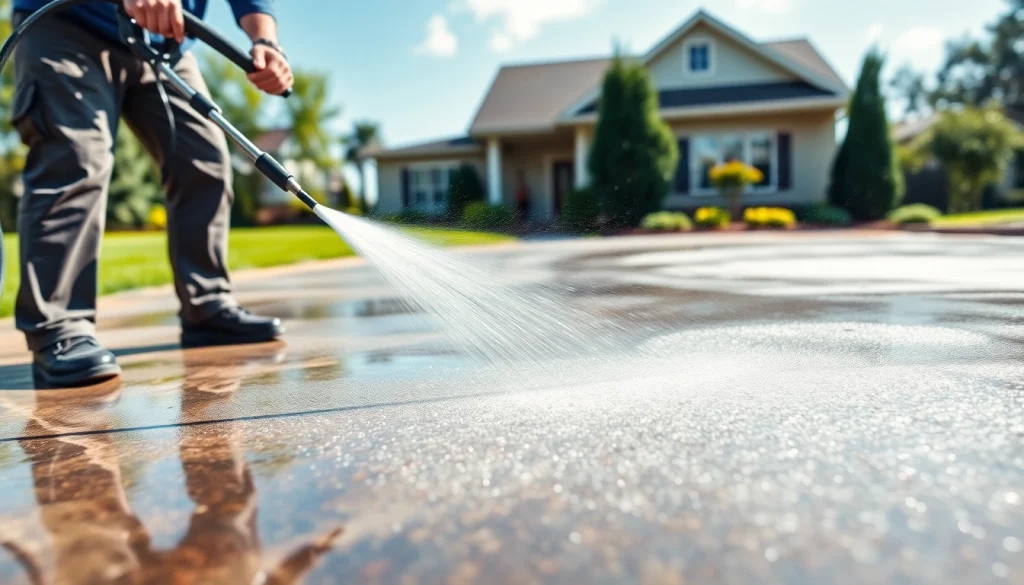
Understanding Pressure Washing: What Is It?
1. The Basics of Pressure Washing
Pressure washing, also known as power washing, is a cleaning technique that utilizes high-pressure water spray to remove dirt, grime, mud, mildew, loose paint, and other contaminants from surfaces. This method is particularly effective for tough stains on various materials including concrete, wood, and metal. Pressure washing has become a popular choice for both residential and commercial cleaning projects. The machinery typically includes a motor and a powerful pump that forces water through a narrow nozzle, greatly increasing its velocity and cleaning capability.
2. Common Applications of Pressure Washing
Pressure washing is utilized in a variety of settings and for numerous applications:
- Residential Cleaning: Homeowners frequently use pressure washing to clean driveways, patios, decks, and siding, restoring their appearance dramatically.
- Commercial Cleaning: Businesses employ pressure washing to keep storefronts, sidewalks, and parking lots free from spills and debris, contributing to their visual appeal and safety.
- Industrial Applications: Factories may use high-pressure washing to maintain equipment and eliminate hazardous materials from workspaces.
- Roof and Gutter Cleaning: Pressure washing is also effective for cleaning roofs and gutters, removing moss, algae, and debris that can cause long-term damage.
3. Safety Precautions in Pressure Washing
Pressure washing can be dangerous if not performed correctly. Here are some safety precautions to consider:
- Use Protective Equipment: Always wear safety glasses, gloves, and non-slip footwear when handling a pressure washer.
- Check Equipment Before Use: Ensure hoses and nozzles are in good condition to prevent accidents such as hoses bursting.
- Be Aware of Surroundings: Avoid spraying near people, pets, or fragile plants, and ensure electrical connections are safe from water.
- Understand the Nozzle Types: Different nozzles spray water at different angles; using the wrong one can damage surfaces or cause injury.
Benefits of Pressure Washing for Homeowners
1. Enhancing Curb Appeal
One of the most immediate benefits of pressure washing is the enhancement of a property’s curb appeal. Algae, dirt, and grime can accumulate on homes over time, making them look worn and unwelcoming. A thorough pressure wash can rejuvenate your home’s exterior, making it more attractive to visitors and potential buyers.
2. Preventing Algae and Mold Growth
Neglecting regular cleaning can lead to the growth of algae and mold, which not only deteriorate surfaces but can also pose health hazards. Regular pressure washing prevents these contaminants from taking hold, thus ensuring a healthier environment for the occupants of the home.
3. Increasing Property Value Through Pressure Washing
A well-maintained exterior enhances the overall value of a property. Potential buyers are often deterred by dirty exteriors and neglected surfaces. By investing in pressure washing, homeowners can improve the aesthetics and functionality of their property, making it more desirable in the competitive real estate market.
Choosing a Professional Pressure Washing Service
1. Key Questions to Ask Potential Contractors
When considering hiring a professional pressure washing service, it’s crucial to ask the right questions to gauge their reliability and expertise. Here are some essential questions:
- What type of equipment do you use?
- Are you insured and licensed?
- Can you provide references from previous clients?
- What are your cleaning processes and products?
2. Evaluating Pressure Washing Quotes
When receiving quotes, homeowners should compare multiple options while considering what is included. Be wary of unusually low prices, which may indicate poor service or hidden fees. A quality quote typically includes a detailed breakdown of services, estimated time, and coverage of potential additional costs.
3. Checking Reviews and References
Before hiring, check online reviews and ask for references from the service provider. This feedback can provide valuable insights into the quality and reliability of their work and customer service. Popular platforms include Google Reviews, Yelp, and Angie’s List.
DIY vs. Professional Pressure Washing: What’s Best?
1. Pros and Cons of DIY Pressure Washing
There are scenarios where a DIY approach to pressure washing might be suitable:
- Pros:
- Cost savings: Owning or renting a pressure washer can be more economical for frequent use.
- Control: You can set your own schedule and cleaning approach.
- Cons:
- Risk: Without experience, homeowners may damage surfaces or injure themselves.
- Time-consuming: DIY pressure washing can take longer than hiring professionals who have expertise and efficient processes.
2. Situations Where You Should Hire Professionals
While many tasks can be approached as a DIY project, certain situations warrant hiring professionals:
- If you are cleaning hard-to-reach areas, such as multi-story homes or rooftops.
- When extensive surface cleaning is required, such as mold infestations.
- If you lack the time or confidence to perform the job safely.
3. How to Rent Equipment for DIY Pressure Washing
If you choose to tackle pressure washing yourself, renting the necessary equipment is straightforward. Local home improvement stores typically offer a range of pressure washers for rent:
- Choose the Right Model: Select a pressure washer that meets your cleaning needs, usually measured in PSI (pounds per square inch).
- Safety Instructions: Ensure that you familiarize yourself with the equipment’s operation manual and safety guidelines.
- Ask for Assistance: Don’t hesitate to ask store personnel for assistance in selecting the right equipment based on your project requirements.
Maintaining Your Surfaces Post-Pressure Washing
1. Long-term Maintenance Tips
Maintaining surfaces after pressure washing is crucial to keeping them looking clean longer:
- Apply sealants: After cleaning, consider applying a sealant to concrete or wooden surfaces to help prevent future staining.
- Regularly inspect: Keep an eye out for signs of growth, cracking, or staining that may require attention.
- Avoid landscaping contact: Maintain a safe distance between pressure-washed surfaces and plant materials to avoid damaging growth.
2. Products to Use After Pressure Washing
When cleaning surfaces, consider using these products post-pressure washing:
- Algaecides and Mold Preventives: These can further protect your surfaces from future growth.
- Sealants: For wooden decks or porous surfaces, using a sealant can keep moisture and grime at bay.
- Cleaning Agents: Non-toxic cleaners can help maintain cleanliness without harming the environment.
3. Scheduling Regular Pressure Washing Services
To maintain the longevity of your property surfaces, it’s advised to schedule regular pressure washing services. This may depend on environmental factors, usage, and the type of surfaces:
- For instance, homes in humid environments may need pressure washing every 6-12 months.
- Commercial properties with heavy foot traffic may require more frequent services.
- Consulting with a professional can help tailor a regular cleaning schedule that fits specific needs.






